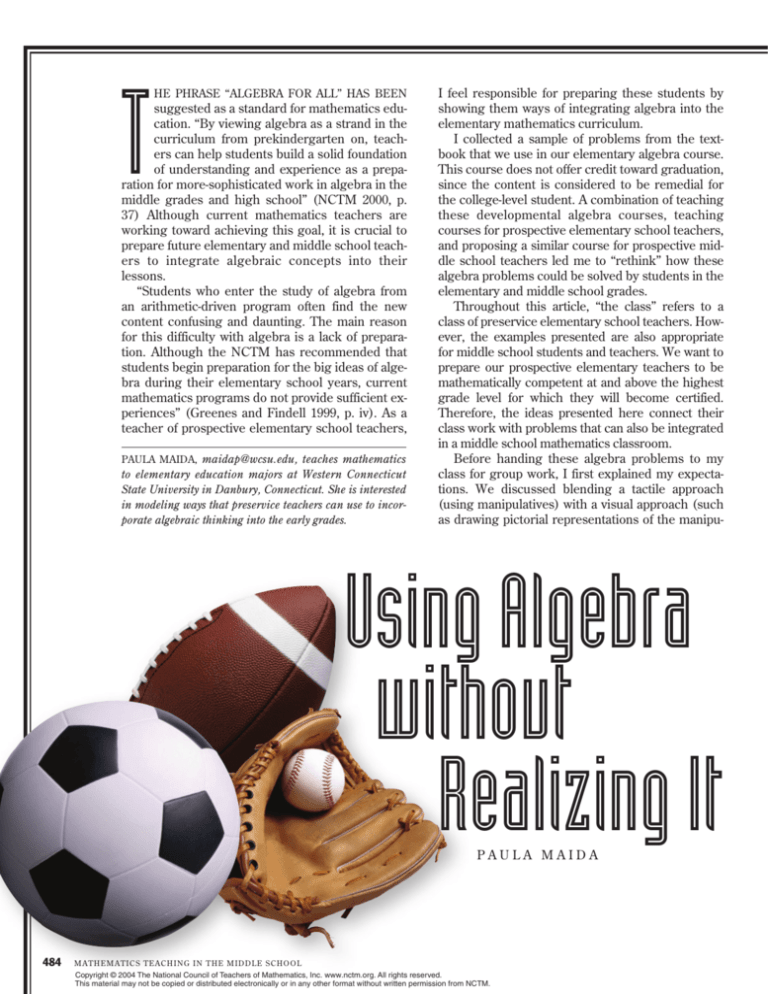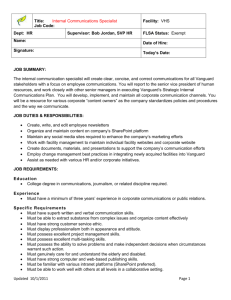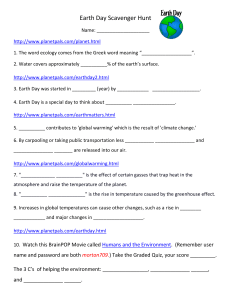
T
HE PHRASE “ALGEBRA FOR ALL” HAS BEEN
suggested as a standard for mathematics education. “By viewing algebra as a strand in the
curriculum from prekindergarten on, teachers can help students build a solid foundation
of understanding and experience as a preparation for more-sophisticated work in algebra in the
middle grades and high school” (NCTM 2000, p.
37) Although current mathematics teachers are
working toward achieving this goal, it is crucial to
prepare future elementary and middle school teachers to integrate algebraic concepts into their
lessons.
“Students who enter the study of algebra from
an arithmetic-driven program often find the new
content confusing and daunting. The main reason
for this difficulty with algebra is a lack of preparation. Although the NCTM has recommended that
students begin preparation for the big ideas of algebra during their elementary school years, current
mathematics programs do not provide sufficient experiences” (Greenes and Findell 1999, p. iv). As a
teacher of prospective elementary school teachers,
PAULA MAIDA, maidap@wcsu.edu, teaches mathematics
to elementary education majors at Western Connecticut
State University in Danbury, Connecticut. She is interested
in modeling ways that preservice teachers can use to incorporate algebraic thinking into the early grades.
I feel responsible for preparing these students by
showing them ways of integrating algebra into the
elementary mathematics curriculum.
I collected a sample of problems from the textbook that we use in our elementary algebra course.
This course does not offer credit toward graduation,
since the content is considered to be remedial for
the college-level student. A combination of teaching
these developmental algebra courses, teaching
courses for prospective elementary school teachers,
and proposing a similar course for prospective middle school teachers led me to “rethink” how these
algebra problems could be solved by students in the
elementary and middle school grades.
Throughout this article, “the class” refers to a
class of preservice elementary school teachers. However, the examples presented are also appropriate
for middle school students and teachers. We want to
prepare our prospective elementary teachers to be
mathematically competent at and above the highest
grade level for which they will become certified.
Therefore, the ideas presented here connect their
class work with problems that can also be integrated
in a middle school mathematics classroom.
Before handing these algebra problems to my
class for group work, I first explained my expectations. We discussed blending a tactile approach
(using manipulatives) with a visual approach (such
as drawing pictorial representations of the manipu-
Using Algebra
without
Realizing It
PAULA MAIDA
484
MATHEMATICS TEACHING IN THE MIDDLE SCHOOL
Copyright © 2004 The National Council of Teachers of Mathematics, Inc. www.nctm.org. All rights reserved.
This material may not be copied or distributed electronically or in any other format without written permission from NCTM.
lative and creating number sentences with these illustrations). I explained that their future students
need time to explore with concrete manipulatives
so that they learn to translate the physical objects
into mathematical symbols. For example, it is typical for a first grader to use three counting tiles to
represent the number 3. As children reach the middle school grades, it is important for their algebra
preparation that they have opportunities to visualize
those same three counting tiles as being something
other than the number 3. For instance, they could
explore scenarios, such as that—
Using Substitution
A PROBLEM FROM THE TEXTBOOK WAS EXPLORED:
Together, a baseball and a football weigh 1.25
pounds, the baseball and a soccer ball weigh 1.35
pounds, and the football and the soccer ball weigh
1.9 pounds. How much does each of the balls
weigh? (Musser, Burger, and Peterson 2001, p. 15)
The class reasoned that a fifth-grade student,
named Sanchez, might illustrate the given information as shown:
• each tile represents 1/2 hour of household
chores. When 3 tiles are accumulated (that is,
1 1/2 hours of chores are performed) the student receives an allowance.
• each tile represents 12 fluid ounces of soda in a soda
can. “If your friend drinks the equivalent of 3 counting tiles, how many fluid ounces did she drink?”
The students should then be encouraged to create their own interpretations, model their own ideas
of what the tiles represent, and create questions to
ask their classmates regarding how they defined a
tile. This practice leads to using the three counting
tiles to represent an unknown quantity. For instance, this problem could be given:
Let
= weight of baseball (in pounds)
Let
= weight of football (in pounds)
Let
= weight of soccer ball (in pounds)
(Note that these symbols prepare Sanchez for
defining variables later in formal algebraic work.
Variables will replace the pictures.)
Fact 1:
+
= 1.25 pounds
Fact 2:
+
= 1.35 pounds
+
Fact 3:
You were so hungry during lunch one day that
you bought 3 chocolate chip cookies in the cafeteria. The total cost of the cookies was $1.95.
(Each cookie had the same cost and there was
no sales tax.) Use pictorial representation (pictures) to make a number sentence about the information given. Then show a way to determine
how much each cookie costs.
This phase was the focus of my lesson with the preservice teachers. We began by doing the following
problem from their course textbook together. I
asked them to envision how younger, nonalgebra
students could tackle this problem, without realizing that they were using algebra. I explained that a
goal is to encourage the use of manipulatives and
pictures so that the problem appears to be easier to
solve. The remaining role for the teacher is to show
the transition from an actual manipulative, such as
a ball, to a variable, such as the letter b. We briefly
discussed their past experience with solving traditional algebra problems by using variables. I purposely did not remind them of strategies for solving
systems of equations (e.g., elimination by addition)
because I was interested in discovering what they
would do when it was their turn to explore problems with manipulatives.
= 1.9 pounds
Sanchez realizes that each fact by itself does not
provide enough information. He must use at least
two facts together. He combines the balls from fact
1 and fact 2 and calculates the combined weight to
be 2.6 pounds.
+
+
+
= 2.6 pounds
Again, Sanchez finds himself in a situation where he
has too many pieces of unknown information in his
number sentence. He wonders if fact 3 is useful yet.
Actually, he notices that a football and a soccer ball
weigh 1.9 pounds. He substitutes the 1.9 pounds for
the football and soccer ball and subtracts their weight
from both sides of the equation.
+
+
+
= 2.6 pounds – 1.9 pounds
He deduces that two baseballs weigh 0.7 pounds.
Therefore, each baseball weighs 0.35 pounds.
+
So
= 0.7 pounds
= 0.35 pounds
V O L . 9 , N O . 9 . MA Y 2 0 0 4
485
Sanchez uses fact 1 to determine the football’s weight:
+
= 1.25 pounds – 0.35 pound
So
= 0.9 pounds
(As a class, we discussed how subtracting 0.35 from
both sides of the equation 0.35 + football icon = 1.25
keeps the equation balanced, as if a 0.35 weight was
taken off both sides of a balance scale. We also considered using the missing addend approach, 0.35
plus what number gives 1.25, which is represented
by the subtraction problem 1.25 – 0.35 = 0.9.)
From fact 2, he finds the soccer ball’s weight:
+
= 1.35 pounds – 0.35 pound
So
= 1 pound
Using algebraic symbolism, Sanchez’s work would
be shown this way:
suggest that the soccer ball must weigh 0.1 pounds
more than the football. They used this information
with fact 3 to determine that the football weighed
0.9 pounds and that the soccer ball weighed 1
pound.
After discussing this problem together as a
class, the students were asked to do the next two
problems (taken from the college algebra textbook) in a group-work setting. They were asked to
think like a young child by drawing pictures and
avoiding the use of variables. It is interesting to
note that a few students did solve the problems by
using variables, even though I asked them not to.
When I asked them why, they responded that they
were so used to solving problems of this type by
using variables that they could not solve them
without variables. The students’ struggles suggested to me that these preservice teachers need
more practice with these strategies if they are expected to naturally implement them in their own
classrooms.
Using Elimination by Subtraction
THIS PROBLEM AND MANIPULATIVES WERE
explored next.
Let B = the weight of the baseball (in pounds)
Let F = the weight of the football (in pounds)
Let S = the weight of the soccer ball (in pounds)
Fact 1: B + F = 1.25
Fact 2: B + S = 1.35
Fact 3: F + S = 1.9
Working with 3 equations with 3 unknowns can be a
difficult task. By combining fact 1 and fact 2, an
algebra student can rewrite this system as two
equations:
How do the Quarter Pounder and Whopper with
cheese measure up in the calorie department?
Actually, not too well. Two Quarter Pounders
and three Whoppers with cheese provide 2607
calories. Even one of each provides enough calories to bring tears to Jenny Craig’s eyes—9 calories in excess of what is allowed on a 1000 caloriea-day diet. Find the caloric content of each item.
(Blitzer 2002, p. 303)
To solve this problem, the class used Unifix cubes to
represent the hamburgers. They decided that the
Facts 1 and 2: 2B + F + S = 2.6
Fact 3: F + S = 1.9
2B + 1.9 = 2.6
2B = 0.7
B = 0.35
Substitute the value of B into facts 1 and 2 to find
that F = 0.9 and S = 1.0.
Of course, there are a variety of ways to solve
this problem. For instance, when I asked my class
of prospective elementary education students to
tackle the ball problem, some students used different reasoning. They noticed that fact 1 and fact 2
486
MATHEMATICS TEACHING IN THE MIDDLE SCHOOL
PHOTOGRAPH BY PAULA MAIDA; ALL RIGHTS RESERVED
The algebra student could now use substitution
of fact 3 into the fact 1 and fact 2 combination to obtain this information:
Unifix cubes double as both Quarter Pounders (the brown
cubes) and Whoppers with cheese (the yellow cubes).
brown cubes reminded them of a hamburger, so 1
brown cube was a Quarter Pounder and the orange
cubes reminded them of the cheese on the Whopper, so 1 orange cube was a Whopper with cheese.
They were asked to document their work. Figure 1
is a sample of a student’s work. Using algebraic sym-
Answer the question in the following Peanuts cartoon strip. (Note: You may not use the answer given
in the cartoon!) (Blitzer 2002, p. 146)
PEANUTS © UNITED FEATURE SYNDICATE, INC. ALL RIGHTS RESERVED.
A sample of a student’s work is shown in figure
2. When I returned my students’ work to them, I
mentioned that this problem could appropriately be
Fig. 1 Calories are computed through the use of Unifix cubes.
bolism, this student’s work would be set up this way:
Let Q = calories in a Quarter Pounder
Let W = calories in a Whopper with cheese
Fact 1: 2Q + 3W = 2607
Fact 2: Q + W = 1009
(Note that students must be encouraged to use multiplication rather than repeated addition. That is, W
+ W + W means 3 of W or 3W.) Double both sides of
the second equation to obtain the following:
2Q + 3W = 2607
2Q + 2W = 2018
Subtracting the second equation from the first equation, W = 589. Substituting this fact into one of the
original equations yields Q = 420. Therefore, a
Quarter Pounder contains 420 calories, and a
Whopper with cheese contains 589 calories.
Using Logical Reasoning
Fig. 2 A Peanuts cartoon slides into an exploration of weight.
given after teaching the addition of fractions with
the use of fraction bars. I modeled a classroom scenario for them.
Suppose that Rebecca used the idea of the balance
scale to conclude that the banana peel weighs 7/8
ounce. To use Peppermint Patty’s statement that a
banana peel weighs 1/8 the total weight of a banana, she decides to use her fraction bars.
Rebecca lets the whole banana weight be represented by a whole fraction bar:
whole banana
MANY STUDENTS ENJOY SEEING MATHEMATICS
joked about in cartoons.
V O L . 9 , N O . 9 . MA Y 2 0 0 4
487
PHOTOGRAPH BY PAULA MAIDA; ALL RIGHTS RESERVED
Therefore, using the statement that a banana
peel weighs 1/8 the total weight of a banana, Rebecca explains by using a diagram:
Let W = the weight of the whole banana, i.e., banana with peel (in ounces)
Fact 1: B + P = B + 7/8. By subtracting B from both
sides, P = 7/8.
Fact 2: P = 1/8 × W. By substituting fact 1 information into fact 2, we have 7/8 = 1/8 × W. By multiplying both sides by 8, we obtain W = 7. Therefore, the
weight of the banana with peel is 7 ounces.
This is just
the peel.
7/8 oz.
Since she already concluded that the banana peel
weighs 7/8 ounce, she continues her explanation:
whole banana
7/8 oz. 7/8 oz. 7/8 oz. 7/8 oz. 7/8 oz. 7/8 oz. 7/8 oz.
The peel weighs 7/8 ounce.
So each part this size represents 7/8 ounce.
So the whole banana weighs 7/8 + 7/8 + 7/8 + 7/8 +
7/8 + 7/8 + 7/8 + 7/8 = 56/8 = 7 ounces. Therefore,
the banana with peel weighs 7 ounces. (Note that
some students will perform the repeated addition
faster with multiplication: 8 of 7/8 is 8 × 7/8 = 7.)
Although there are different ways to solve this problem algebraically, a symbolic approach analogous to
the work above could be shown this way:
Let B = the weight of the banana without the peel
(in ounces)
Let P = the weight of just the banana peel (in
ounces)
488
MATHEMATICS TEACHING IN THE MIDDLE SCHOOL
In conclusion, as students begin to use manipulatives and represent their pictures with number
sentences, they are subconsciously internalizing algebraic concepts without even realizing it. The
hands-on manipulatives and pictorial representations will not only engage tactile and visual learners, but will also expand all students’ mathematical
experiences. This exposure and growth is beneficial, if not vital, to their understanding and appreciation of algebra when it is formally introduced to
them in later years.
References
Blitzer, Robert. Introductory Algebra for College Students.
Upper Saddle River, N.J.: Prentice Hall, 2002.
Greenes, Carole, and Carol Findell. Groundworks: Algebraic Thinking, Grade 3. Chicago, Ill.: Creative Publications, 1999.
Musser, Gary L., William F. Burger, and Blake E. Peterson. Mathematics for Elementary Teachers: A Contemporary Approach, 5th ed. New York, N.Y.: John Wiley
& Sons, 2001.
National Council of Teachers of Mathematics (NCTM).
Principles and Standards for School Mathematics.
Reston, Va.: NCTM, 2000.




